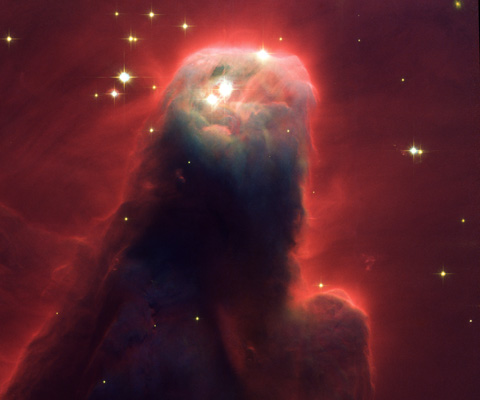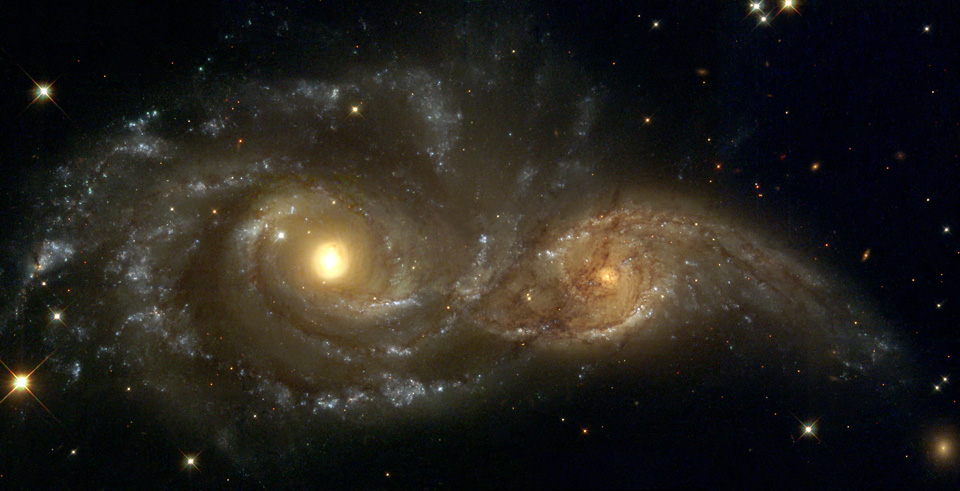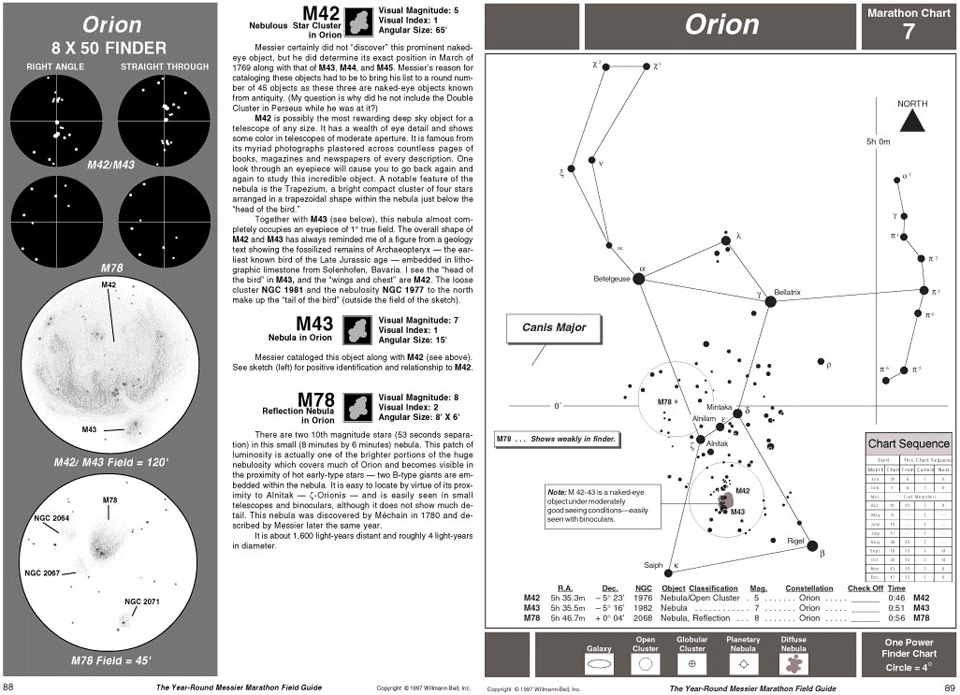Introduction
By no means complete, January’s mini guide that follows provides notes for exploring various interesting deep sky objects (DSOs) and lists other items of interest useful to the amateur astronomer.
Entries can be interpreted based on designation, description and magnitude as follows.
Designation – Description – Magnitude:
★ Telescopes 10-inch aperture minimum.
★★ Telescopes 6-inch to 9-inch aperture.
★★★ Binoculars (50mm+ aperture) and telescopes
3-inch to 5-inch aperture.
A collimated instrument, favourable atmospheric conditions, dark skies and dark-adapted eyes are assumed.

Credit: NASA, H. Ford (JHU), G. Illingworth (UCSC/LO), M.Clampin (STScI), G. Hartig (STScI), the ACS Science Team, and ESA.
About NGC 2264 nebula
Resembling a nightmarish beast rearing its head from a crimson sea, this monstrous object is actually an innocuous pillar of gas and dust. Called the Cone Nebula (and catalogued NGC 2264) is so named because, in ground-based images, it has a conical shape. This giant pillar resides in a turbulent star-forming region. NASA's Hubble Space Telescope imaged the "Cone Nebula," a nebula close to home. It exhibits a craggy-looking mountaintop of cold gas and dust that is a cousin to Hubble's iconic "pillars of creation" in the Eagle Nebula, photographed in 1995.
Image credit: NASA, H. Ford (JHU), G. Illingworth (UCSC/LO), M.Clampin (STScI), G. Hartig (STScI), the ACS Science Team, and ESA.
The ACS Science Team: H. Ford, G. Illingworth, M. Clampin, G. Hartig, T. Allen, K. Anderson, F. Bartko, N. Benitez, J. Blakeslee, R. Bouwens, T. Broadhurst, R. Brown, C. Burrows, D. Campbell, E. Cheng, N. Cross, P. Feldman, M. Franx, D. Golimowski, C. Gronwall, R. Kimble, J. Krist, M. Lesser, D. Magee, A. Martel, W. J. McCann, G. Meurer, G. Miley, M. Postman, P. Rosati, M. Sirianni, W. Sparks, P. Sullivan, H. Tran, Z. Tsvetanov, R. White, and R. Woodruff.
| January deep sky objects |
| Gemini constellation |
|
NGC2392
|
The Eskimo Nebula is a planetary nebula close to the double star 63 Geminorum. It can be viewed in a 3-inch instrument but requires magnifications around x120 to make up its shape. Larger instruments and CCDs reveal additional detail that show up as the ‘Eskimo’s parka’.
|
9.35
|
★★★
|
|
NGC2371
|
Planetary nebula. Large instruments will show its two separate halves.
|
11.0
|
★★
|
|
NGC2420
|
A small open cluster consisting of approximately 1,000 stars.
|
10.2
|
★★
|
|
NGC2266
|
A compact open cluster comprising of stars around 1 billion years in age. The four brighter stars lie in curved line.
|
9.80
|
★★
|
|
NGC2339
|
A small bared spiral galaxy accessible to medium size scopes and above.
|
12.5
|
★★
|
|
NGC2158
|
An open cluster with over 100 stars.
|
11.0
|
★★
|
|
M35
|
Large and bright open cluster consisting of around two hundred of stars. Offers pleasing views though binoculars and small instruments.
|
5.5
|
★★★
|
| Lynx constellation |
|
NGC2419
|
Globular cluster 250,000 light years away.
|
10.4
|
★★
|
|
NGC2683
|
Nearly edge-on spiral galaxy.
|
10.7
|
★★
|
|
NGC2832
|
Spiral galaxy with other galaxies in the same field of view.
|
12.8
|
★
|
| Monoceros constellation |
|
NGC2264
|
The Christmas Tree Cluster is a large and bright star cluster, visible to the unaided eye it will show around 20 stars with binoculars. Large instruments will detect nebulosity but he beauty of this cluster comes through CCDs and long exposures.
|
4.7
|
★★★
|
|
NGC2244
|
Open cluster with nebulosity.
|
6.20
|
★★
|
|
NGC2237
|
The Rosette nebula is a diffuse spherical nebula. It is best viewed with binoculars or small instruments due to its low surface brightness.
|
4.8
|
★★
|
|
M50
|
An open star cluster with 508 confirmed members than can be observed with the unaided eye under dark skies. In large instruments it reveals a large number of stars some forming various patterns shaped by brighter blue stars.
|
7.0
|
★★★
|
|
NGC2506
|
Mildly elongated open cluster with approximately 94 members.
|
8.50
|
★★★
|
| Canis Major constellation |
|
M41
|
The Small Beehive is a cluster of approximately 25 stars the largest of which is a reddish 7th magnitude star located in the centre. Visible to the unaided eye under dark skies.
|
5.0
|
★★★
|
|
NGC2360
|
Star cluster with around 100 stars.
|
9.40
|
★★
|
|
NGC2207
|
A distorted galaxy between the constellations of Canis Major and Lepus. Difficult to observe as it stays close to the Horizon.
|
11.8
|
★
|
|
IC2163
|
Companion galaxy to the NGC2207. Difficult to observe as it stays close to the horizon.
|
12.4
|
★
|
| Puppis constellation |
|
M46
|
Large and rich open cluster with an estimated 500 stars. The NGC 2348 planetary nebula behind the cluster adds to the view. Lies in the same field of view with the M47 and NGC2423.
|
6.50
|
★★★
|
|
M47
|
Open cluster with a large number of stars.
|
4.50
|
★★★
|
|
M93
|
Bright open cluster with about 80 stars. Its core resembles an arrowhead.
|
6.50
|
★★★
|
|
NGC2438
|
Planetary nebula by the M46, Extended exposures will reveal an extended double halo.
|
11.3
|
★★
|
|
NGC2359
|
Bright Emission diffuse nebula with lots of detail. Colour imaging this nebula will prove rewarding.
|
11.4
|
★★
|
|
|
Designation, Description, Magnitude
|
★ Telescopes 10-inch aperture minimum.
★★ Telescopes 6-inch to 9-inch aperture.
★★★ Binoculars (50mm+ aperture) and telescopes 3-inch to 5-inch aperture.
|
The night sky
Under excellent conditions over 2,000 stars can be seen with the unaided eye but only a few hundred of these are prominent enough to be useful in navigating the night sky, these are normally included in amateur sky maps and digital planetarium programs like the SkySafari, Stellarium, The Sky, Starry Night, Winstars 2 etc. Some stars will show colour that is useful in identifying them. For example, Antares, Betelgeuse and Aldebaran are orange/red where Vega, Rigel and Spica appear as blue/white.
Stars that form easily recognisable patterns have been given names and are referred to as constellations. Of these, the brightest stars act as beacons and can be used to effectively navigate the night sky during the different months of the year. To that extent stars can be particularly useful in locating other interesting objects nearby normally viewable through binoculars or larger instruments.
Planets and their satellites, comets and meteors move independent of the night sky background and at comparatively high speeds. They are therefore very difficult or impossible to reference to any star. However, planets like Jupiter, Saturn, Venus and Mars as well as the Moon are easy to spot with the unaided eye and in the case of the larger planets and especially the Moon, even medium size binoculars will reveal a limited degree of detail.
NGC 2207 and IC 2163 spiral galaxies

Credit: NASA/ESA and The Hubble Heritage Team (STScI).
In the direction of the constellation Canis Major, two spiral galaxies pass by each other like majestic ships in the night. The near-collision has been caught in images taken by the NASA/ESA Hubble Space Telescope and its Wide Field Planetary Camera 2.
Image credit: NASA/ESA and The Hubble Heritage Team (STScI).
Sky conditions
The prevailing sky conditions will have a significant effect on what you can see through any instrument and binoculars. As such if you live near a city the light pollution can make it difficult to locate and observe most DSOs. The Moon and a hazy sky will also have a negative effect.
For best results observe from a dark site and under clear transparent skies without the moon being present. Once your eyes have been accustomed to the dark conditions (this takes around 20-30 minutes) you should be able to enjoy the night sky at its best.
Filters
Filters will help to an extent and lager instruments will benefit more from them. Light pollution filters would help and photo-visual UHC (nebula filters) would be worth considering.
Printed aids
A huge number of printed aids exist in terms of deep sky maps and books. An excellent printed guide for people new in astronomy is The Year-Round Messier Marathon Field Guide published by Willmann Bell Inc.
In this large format hard-back book, the author, Harvard Pennington shows how to:
- Learn 17 bright finder stars and 17 prominent finder constellations so you will know where to look for all 110 Messier objects.
- Align a sighting device such as an 8x50 finder scope or the Telrad® so that you can point your instrument rapidly and with assurance toward all of the Messier objects.
- Calibrate your instrument so that you know exactly how much sky you see through your finder and through the eyepiece of your instrument.
- Find all of the Messier objects using the maps, drawings and descriptions in this book. You will know exactly where to point your instrument, and what the object should look like when you find it.

Extract from The Year-Round Messier Marathon Field Guide
published by Willmann Bell Inc.
Related topics:
night sky, deep sky object guide, January



